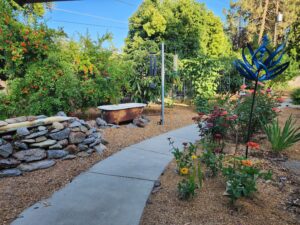Master gardener grows food, flowers instead of lawn
By Debbie Arrington
 Waste not, want not; that philosophy underlines Janelle Auyeung creative approach to gardening. The result is a suburban oasis full of life – and food – to nourish the body as well as the soul.
Waste not, want not; that philosophy underlines Janelle Auyeung creative approach to gardening. The result is a suburban oasis full of life – and food – to nourish the body as well as the soul.
“Over the past two decades, my garden has transformed from a typical lawn into a thriving ecosystem, driven by a vision of sustainability and resilience,” says Auyeung, who lives in Arden Park. “That’s what I’m passionate about – more sustainable living.”
Originally, her yard was a “plain old lawn,” devoid of biodiversity, she says. Little by little, she transformed it into her food- and flower-filled “Summer Strong Yard.”
Auyeung grew up in China, where her family produced much of its own food. “I learned to use resources sparingly,” she recalls.
Auyeung works as a scientist at the California Air Resources Board on climate issues, and has been in the environmental protection field for more than two decades, working on various initiatives. She has made sustainability her life focus and takes that same approach to her Sacramento landscape, which she has been working on for more than 20 years.
Kitchen waste becomes compost to feed her 30 fruit trees, abundant vegetable garden and thriving native plants. Homemade mulch retains moisture and keeps roots comfortable. She also “harvests” rainwater from a capture system attached to her home’s roof gutters and downspouts.
“When it rains, I can capture 3,000 gallons off the roof,” she says. “I use rainwater to brew compost tea. I put the compost tea into the drip irrigation system and it goes directly into the garden.”
Auyeung is both a Sacramento County master gardener and master food preserver. “I grow so much stuff, I had to learn how to preserve it,” she says.
With only a 0.3-acre lot, the yield from her bountiful garden is phenomenal. “Last year, I harvested more than 100 pounds of tomatoes,” she says. “I picked 200 pounds of persimmons. I have five kinds of citrus plus loquats, apricots, pomegranates; so much fruit.”
All while saving time and water, she says. “Once established, fruit trees don’t need too much work and there’s plenty to share with neighbors and co-workers.”
Besides edible plants, Auyeung concentrated on adding California natives as well as drought- and heat-tolerant flowering plants to attract pollinators.
“My garden is alive with so many beneficial insects,” she says. “Birds visit more often and stay longer. There’s so much biodiversity.
“Sustainability has become a way of life,” she adds. “My garden stands as a testament to what can be achieved with dedication, knowledge, and respect for the natural world.”

